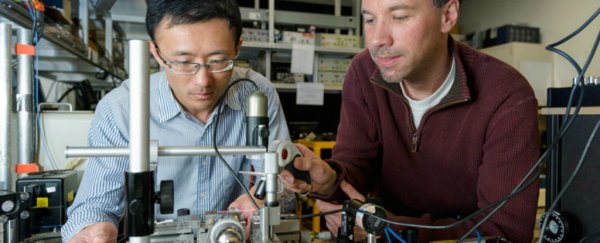Researchers in the US have set a new quantum record, using photons to carry messages between two electrons almost 2 km (1.2 miles) apart.
This is a really big deal, because it brings us a step closer to figuring out how to send quantum entangled particles over long distances, which is what we need to accomplish in order to set up an unhackable quantum communication network - the kind that's of so much interest to governments and banks.
But let's back up a second here, because you're probably wondering why we need to use photon messengers to transport quantum information – after all, the very basis of quantum systems is entanglement, which means that two or more particles are inextricably linked no matter how far apart they are.
When we're talking about quantum computers, the information is stored in the spin of an electron. And when two electrons are entangled, it means whatever happens to one entangled electron will immediately be reflected in its partner even if they're located on opposite sides of the Universe. This is what Einstein called spooky action at a distance.
That's all relatively simple, and quantum entanglement has already allowed information to be passed over great distances. But here's the problem – to entangle electrons, scientists need to have them together before sending them across great distances, which isn't entirely practical when you're talking about setting up communication between hundreds and thousands of electrons, each housed inside their own separate atoms inside quantum computers all over the world.
So in this case, to transmit information between two electrons that have never met, researchers need to entangle them from a distance. This can be achieved by correlating photons with an electron's spin, and then sending the photons to run into each other and pass on the message.
In the past, this process has worked over a distance of several metres, but scientists have struggled to send messages any further, because photons have the tendency of changing their orientation (known as their polarisation) while travelling via optical fibres, and as soon as that happens, the correlation with the electron's spin – and the message – is lost.
But now a team from Stanford University has managed to keep that correlation across almost 2 km of optical fibres, setting a new record for the transmission of quantum information.
"Electron spin is the basic unit of a quantum computer," said lead research Leo Yu. "This work can pave the way for future quantum networks that can send highly secure data around the world."
So how do you preserve quantum information in photons that tend to change their polarisation all the time? Instead of correlating the polarisation to the electron's spin, Yu and his team created a time-stamp, so that they could correlate the arrival time of a photon with the spin of an electron.
They set up this correlation between two photons and two electrons, with each pair separated by 2km of optical fibres. Each of these photons were sent through the cable so they could meet in the middle at a 'beam splitter' and interact, passing each other's message back to their respective electrons.
Of course, that posed a challenge in itself, as journalist Bethany Augliere explains for Stanford: "Photons do not normally interact, just two flashlights beams passing through one another, so the researchers had to mediate this interaction called the 'two-photon interference'."
To do that, the team had to make sure that the two photons had the same wavelength, which they did by passing the photons through something called a 'quantum down-converter' before they headed along the optical fibre.
That quantum down-converter matched both their wavelengths, allowing them to interact, and also helping them to travel further along the cable.
"Quantum supercomputers promise to be exponentially faster and more powerful than traditional computers, and can communicate with immunity to hacking or spying," said Yu.
And now we're finally getting closer to building networks that could link these devices, which is pretty exciting.
The research has been published in Nature Nanotechnology.
